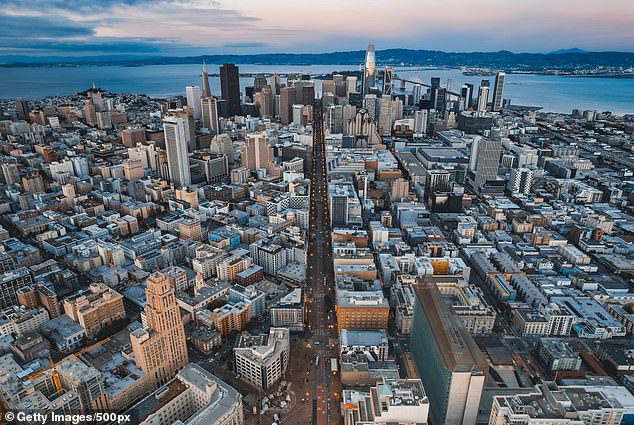
San Francisco, known for its ongoing drug issues and rising crime rates, faces a troubling new crisis: it is gradually sinking into the Pacific Ocean.
Recent findings from a California land motion study conducted by NASA show that many areas along the Northern coast, including the crime-stricken City by the Bay, are experiencing shifts in land elevation due to both natural processes and human activity.
While the city may not be submerged for many centuries, it is already grappling with serious challenges, ranking among the most dangerous cities in the United States.
The ongoing land subsidence, occurring at a rate of mere inches each year, poses significant risks for the future of this urban area.
‘In many parts of the world, such as the reclaimed land beneath San Francisco, the ground is subsiding faster than the sea is rising,’ stated Marin Govorcin, a remote sensing scientist at NASA’s Jet Propulsion Laboratory.
The geological shifts noted by NASA threaten to heighten the risks of flooding, wave impacts, and saltwater intrusion in the coming years.
This news adds to the woes of a city already burdened with numerous challenges.
The California metro area, historically a stronghold for the LGBTQ+ rights movement, saw its homeless population surge by 10 percent in 2022.

Many regions along California’s Northern coast, including the crime-ridden City by the Bay, appear to be shifting – and sinking – due to natural and human-caused factors, a recent land motion study published by NASA revealed

The rise in the number of homeless, about 8,300 people as of August 2024, has brought numerous associated challenges, including increased drug-related crime and violent behavior.

The shopping center in downtown San Francisco has seen a significant decrease in value and occupancy, plummeting from $1.2 billion in 2016 to just $290 million in 2024.
The surge in homelessness, reaching approximately 8,300 individuals in August 2024, has further exacerbated issues with drug trafficking and violent behavior.
San Francisco’s overdose rate in 2024 was more than twice the national average, as reported by the New York Times.
This rise in homelessness and substance abuse coincided with a more than 20 percent increase in median rent, which now exceeds $3,000 per month, making it one of the country’s priciest places to live, according to Zillow data.
Certain neighborhoods have devolved into areas plagued by squalor, driving some residents to seek refuge elsewhere while local businesses struggle to attract staff.
The Westfield Centre mall stands as a stark example, losing numerous retailers in recent years.
The departure of high-end brands including Michael Kors and Bloomingdales underscores the mall’s decline.
Once a bustling shopping destination, the downtown mall’s worth has dramatically dropped to $290 million in 2024 from its peak of $1.2 billion in 2016.
However, San Francisco is not the only California region facing this peril.

The departure of luxury brands has contributed to the decline of the once-popular mall in downtown San Francisco, leading to increasingly vacant spaces.

Scientists have mapped land subsidence in coastal California cities, illustrating the impact of soil compaction and groundwater withdrawal.

Climate change factors, including rising sea levels, may exacerbate conditions for coastal regions, as shown in projections for Palos Verdes.
According to the NASA study, parts of the Central Valley in California, such as San Rafael, Corte Madera, and Bay Farm Island, are sinking at a steady rate of more than 0.4 inches annually.
This gradual subsidence is likely attributed to sediment compaction, a geological process that compresses soil particles and diminishes their capacity to absorb water, ultimately leading to increased runoff, heightened flooding risks, and poor vegetation growth.
Given these factors, it is projected that local sea levels in low-lying regions could rise by over 17 inches by 2050, significantly exceeding the regional forecast of 7.4 inches.
In rugged coastal regions like the Big Sur mountains and Palos Verdes Peninsula, researchers identified areas of downward motion linked to slow-moving landslides.
In Northern California, sinking patterns have been observed in marshlands and lagoons surrounding San Francisco and Monterey bays, with erosion in these sections identified as a contributing factor.
Residents of Rancho Palos Verdes, a wealthy retirement community that is predominantly Democratic, have been contending with significant land movement issues for the past sixty years.

Torrential rain in early 2023 caused significant landslide damage in the coastal community, as evidenced by aerial views of the destruction in Rancho Palos Verdes.

In the most vulnerable areas, projections indicate that local sea levels could increase by more than 17 inches by 2050, outpacing regional estimates dramatically.

NASA researchers have discovered that land movement in the region is expanding and that landslides are progressing towards the ocean at a rate of four inches per week.
Recent heavy rainfall in 2023 and 2024 has intensified this situation, accelerating landslide activity into previously secure areas.
The neighborhoods on the Palos Verdes Peninsula in Los Angeles County are reportedly sliding toward the ocean at an alarming rate of four inches per week, according to data collected by NASA in late 2024.
Researchers from NASA’s Jet Propulsion Laboratory made this conclusion using radar technology to assess land movement in the peninsula between September and October 2024.
The Portuguese Bend landslide—a nature preserve active since 1956—has already displaced hundreds of residents and is part of a larger landslide complex south of Los Angeles, as noted by NASA.
However, the geologically unstable boundaries outlined in 2007 have become outdated, as the landslide’s effects have extended into populated neighborhoods previously thought to be safe.









